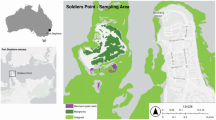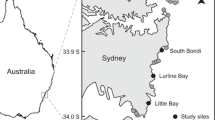Abstract
Oyster reefs are among the most threatened coastal habitat types, but still provide critical habitat and food resources for many estuarine species. The structure of oyster reef food webs is an important framework from which to examine the role of these reefs in supporting high densities of associated fishes. We identified major trophic pathways to two abundant consumers, gray snapper (Lutjanus griseus) and crested goby (Lophogobius cyprinoides), from a subtropical oyster reef using stomach content and stable isotope analysis. The diet of gray snapper was dominated by crabs, with shrimp and fishes also important. Juvenile gray snapper fed almost entirely on oyster reef-associated prey items, while subadults fed on both oyster reef- and mangrove-associated prey. Based on trophic guilds of the gray snapper prey, as well as relative δ13C values, microphytobenthos is the most likely basal resource pool supporting gray snapper production on oyster reefs. Crested goby had omnivorous diets dominated by bivalves, small crabs, detritus, and algae, and thus were able to take advantage of prey relying on production from sestonic, as well as microphytobenthos, source pools. In this way, crested goby represent a critical link of sestonic production to higher trophic levels. These results highlight major trophic pathways supporting secondary production in oyster reef habitat, thereby elucidating the feeding relationships that render oyster reef critical habitat for many ecologically and economically important fish species.



Similar content being viewed by others
References
Beck MW, Heck KL Jr, Able KW, Childers DL, Eggleston DB, Gillanders BM, Halpern B, Hayes CG, Hoshino K, Minello TJ, Orth RJ, Sheridan PF, Weinstein MP (2001) The identification, conservation, and management of estuarine and marine nurseries for fish and invertebrates. Bioscience 51(8):633–641
Beck MW, Brumbaugh DR, Airoldi L, Carranza A, Coen LD, Crawford C, Defeo O, Edgar GJ, Hancock B, Kay M, Lenihan HS, Luckenbach MW, Toropova CL, Zhang G (2009) Shellfish reefs at risk: a global analysis of problems and solutions. The Nature Conservancy, Arlington
Boudreaux ML, Stiner JL, Walters LJ (2006) Biodiversity of sessile and motile macrofauna on intertidal oyster reefs in Mosquito Lagoon, Florida. J Shellfish Res 25(3):1079–1089
Cabana G, Rasmussen JB (1996) Comparison of aquatic food chains using nitrogen isotopes. Proc Natl Acad Sci USA 93(20):10844–10847
Dahlgren CP, Eggleston DB (2000) Ecological processes underlying ontogenetic habitat shifts in a coral reef fish. Ecology 81(8):2227–2240
Dahlgren CP, Kellison GT, Adams AJ, Gillanders BM, Kendall MS, Layman CA, Ley JA, Nagelkerken I, Serafy JE (2006) Marine nurseries and effective juvenile habitats: concepts and applications. Mar Ecol Prog Ser 312:291–295
Dame RF, Patten BC (1981) Analysis of energy flows in an inter-tidal oyster reef. Mar Ecol Prog Ser 5(2):115–124
Darcy GH (1981) Food habits of the crested goby, Lophogobius cyprinoides, in 2 Dade County, Florida, waterways. Bull Mar Sci 31(4):928–932
Eggleston DB, Dahlgren CP, Johnson EG (2004) Fish density, diversity, and size-structure within multiple back reef habitats of Key West National Wildlife Refuge. Bull Mar Sci 75(2):175–204
Faunce CH, Serafy JE (2007) Nearshore habitat use by gray snapper (Lutjanus griseus) and bluestriped grunt (Haemulon sciurus): environmental gradients and ontogenetic shifts. Bull Mar Sci 80(3):473–495
Faunce CH, Serafy JE (2008a) Growth and secondary production of an eventual reef fish during mangrove residency. Estuar Coast Shelf Sci 79(1):93–100
Faunce CH, Serafy JE (2008b) Selective use of mangrove shorelines by snappers, grunts, and great barracuda. Mar Ecol Prog Ser 356:153–162
Fodrie FJ, Kenworthy MD, Powers SP (2008) Unintended facilitation between marine consumers generates enhanced mortality for their shared prey. Ecology 89(12):3268–3274
Grabowski JH (2004) Habitat complexity disrupts predator-prey interactions but not the trophic cascade on oyster reefs. Ecology 85(4):995–1004
Grabowski JH, Kimbro DL (2005) Predator-avoidance behavior extends trophic cascades to refuge habitats. Ecology 86(5):1312–1319
Grabowski JH, Hughes AR, Kimbro DL (2008) Habitat complexity influences cascading effects of multiple predators. Ecology 89(12):3413–3422
Halpern BS, Gaines SD, Warner RR (2005) Habitat size, recruitment, and longevity as factors limiting population size in stage-structured species. Am Nat 165(1):82–94
Harding JM, Mann R (2001) Diet and habitat use by bluefish, Pomatomus saltatrix, in a Chesapeake Bay estuary. Environ Biol Fishes 60(4):401–409
Harding JM, Mann R (2003) Influence of habitat on diet and distribution of striped bass (Morone saxatilis) in a temperate estuary. Bull Mar Sci 72(3):841–851
Howard B, Arrington DA (2008) Assessment of 2007–2008 Loxahatchee River oyster mapping and recruitment (trans: Laboratory WE). Loxahatchee River District, Jupiter
Hughes AR, Grabowski JH (2006) Habitat context influences predator interference interactions and the strength of resource partitioning. Oecologia 149(2):256–264
Jackson JBC, Kirby MX, Berger WH, Bjorndal KA, Botsford LW, Bourque BJ, Bradbury RH, Cooke R, Erlandson J, Estes JA, Hughes TP, Kidwell S, Lange CB, Lenihan HS, Pandolfi JM, Peterson CH, Steneck RS, Tegner MJ, Warner RR (2001) Historical overfishing and the recent collapse of coastal ecosystems. Science 293(5530):629–638
Knott DC (1999) Introduction of the green proecelain crab, Petrolisthes armatus (Gibbes 1850) into the South Atlantic Bight. In: Pederson J (ed) Marine bioinvasions: Proceedings of the 1st national conference, Cambridge. Massachusetts Institute of Technology, p 404
Layman CA (2007) What can stable isotope ratios reveal about mangroves as fish habitat? Bull Mar Sci 80(3):513–527
Layman CA, Post DM (2008) Can stable isotope ratios provide for community-wide measures of trophic structure? Reply. Ecology 89(8):2358–2359
Layman CA, Silliman BR (2002) Preliminary survey and diet analysis of juvenile fishes of an estuarine creek on Andros Island, Bahamas. Bull Mar Sci 70(1):199–210
Layman CA, Winemiller KO (2004) Size-based responses of prey to piscivore exclusion in a species-rich neotropical river. Ecology 85(5):1311–1320
Layman CA, Arrington DA, Langerhans RB, Silliman BR (2004) Degree of fragmentation affects fish assemblage structure in Andros Island (Bahamas) estuaries. Caribb J Sci 40(2):232–244
Layman CA, Winemiller KO, Arrington DA (2005) Describing the structure and function og a Neotropical river food web using stable isotope ratios, stomach contents, and functional experiments. In: Moore JC, De Ruiter PC, Wolters V (eds) Dynamic food webs: Multispecies assemblages, ecosystem developments, and environmental change, vol 3. Elsevier/Acedemic Press, San Diego, pp 395–406
Layman CA, Quattrochi JP, Peyer CM, Allgeier JE (2007) Niche width collapse in a resilient top predator following ecosystem fragmentation. Ecol Lett 10(10):937–944
Lenihan HS, Peterson CH, Byers JE, Grabowski JH, Thayer GW, Colby DR (2001) Cascading of habitat degradation: oyster reefs invaded by refugee fishes escaping stress. Ecol Appl 11(3):764–782
Mathur D (1977) Food habits and competitive relationships of the bandfin shiner in Halawakee Creek, Alabama. Am Midl Nat 97(1):89–100
O’Connor NE, Grabowski JH, Ladwig LM, Bruno JF (2008) Simulated predator extinctions: predator identity affects survival and recruitment of oysters. Ecology 89(2):428–438
Odum WE, Heald EJ (1972) Trophic analyses of an estuarine mangrove community. Bull Mar Sci 22(3):671–738
Paine RT (1980) Food web: linkage, interaction strength and community infrastructure. J Anim Ecol 49(3):667–685
Paine RT (1992) Food web analysis through field measurement of per-capita interaction strength. Nature 355(6355):73–75
Peterson BJ, Fry B (1987) Stable isotopes in ecosystem studies. Annu Rev Ecol Syst 18:293–320
Peterson CH, Grabowski JH, Powers SP (2003) Estimated enhancement of fish production resulting from restoring oyster reef habitat: quantitative valuation. Mar Ecol Prog Ser 264:249–264
Phillips DL, Gregg JW (2003) Source partitioning using stable isotopes: coping with too many sources. Oecologia 136:261–269
Pittman SJ, Caldow C, Hile SD, Monaco ME (2007) Using seascape types to explain the spatial patterns of fish in the mangroves of SW Puerto Rico. Mar Ecol Prog Ser 348:273–284
Polis GA, Winemiller KO (1996) Food webs: integration of patterns and dynamics. Chapman and Hall, New York
Post DM (2002) Using stable isotopes to estimate trophic position: models, methods, and assumptions. Ecology 83(3):703–718
Post DM, Layman CA, Arrington DA, Takimoto G, Quattrochi J, Montana CG (2007) Getting to the fat of the matter: models, methods and assumptions for dealing with lipids in stable isotope analyses. Oecologia 152(1):179–189
Rodney WS, Paynter KT (2006) Comparisons of macrofaunal assemblages on restored and non-restored oyster reefs in mesohaline regions of Chesapeake Bay in Maryland. J Exp Mar Biol Ecol 335(1):39–51
Schoener TW (1968) The Anolis lizards of Bimini: resource partitioning in a complex fauna. Ecology (NY) 49(4):704–726
Serafy JE, Faunce CH, Lorenz JJ (2003) Mangrove shoreline fishes of Biscayne Bay, Florida. Bull Mar Sci 72(1):161–180
Serrano X, Grosell M, Die D, Serafy J (2007) Ecophysiology of the gray snapper: salinity effects on distribution, abundance and behavior. Comp Biochem Physiol Mol Integr Physiol 146(4):24
Shervette VR, Gelwick F (2008) Seasonal and spatial variations in fish and macroinvertebrate communities of oyster and adjacent habitats in a Mississippi estuary. Estuaries Coasts 31(3):584–596
Shulman MJ (1984) Resource limitation and recruitment patterns in a coral reef fish assemblage. J Exp Mar Biol Ecol 74(1):85–109
Shulman MJ, Ogden JC (1987) What controls tropical reef fish populations: recruitment or bethic mortality? An example in the Caribbean reef fish Haemulon flavolineatum. Mar Ecol Prog Ser 39(3):233–242
South Florida Water Management District (2006) Restoration plan for the Northwest fork of the Loxahatchee River (trans: Division WMDCE)
Stuart V, Klumpp DW (1984) Evidence for food-resource partitioning by kelp-bed filter feeders. Mar Ecol Prog Ser 16:27–37
Tolley SG, Volety AK (2005) The role of oysters in habitat use of oyster reefs by resident fishes and decapod crustaceans. J Shellfish Res 24(4):1007–1012
Tolley SG, Volety AK, Savarese M (2005) Influence of salinity on the habitat use of oyster reefs in three southwest Florida estuaries. J Shellfish Res 24(1):127–137
Tolley SG, Volety AK, Savarese M, Walls LD, Linardich C, Everham EM (2006) Impacts of salinity and freshwater inflow on oyster- reef communities in Southwest Florida. Aquat Living Resour 19(4):371–387
Valentine-Rose L, Cherry JA, Culp JJ, Perez KE, Pollock JB, Arrington DA, Layman CA (2007a) Floral and faunal differences between fragmented and unfragmented Bahamian tidal creeks. Wetlands 27(3):702–718
Valentine-Rose L, Layman CA, Arrington DA, Rypel AL (2007b) Habitat fragmentation decreases fish secondary production in Bahamian tidal creeks. Bull Mar Sci 80(3):863–877
Vander Zanden MJ, Rasmussen JB (1999) Primary consumer delta C-13 and delta N-15 and the trophic position of aquatic consumers. Ecology 80(4):1395–1404
Wada E, Mizutani H, Minagawa M (1991) The use of stable isotopes for food web analysis. Crit Rev Food Sci Nutr 30(4):361–371
Wallace RK (1981) An assessment of diet overlap indexes. Trans Am Fish Soc 110(1):72–76
Werner EE, Gilliam JF (1984) The ontogenetic niche and species interactions in size structured populations. Annu Rev Ecol Syst 15:393–425
Werner EE, Hall DJ (1988) Ontogenetic habitat shifts in bluegill: the foraging rate predation risk trade-off. Ecology 69(5):1352–1366
Wilson RM, Chanton J, Lewis G, Nowacek D (2009) Combining organic matter source and relative trophic position determinations to explore trophic structure. Estuaries Coasts 32(5):999–1010
Winemiller KO, Polis GA (1996) Food webs: what can they tell us about the world? In: Polis GA, Winemiller KO (eds) Food webs: integration of patterns and processes. Chapman and Hall, New York, pp 1–22
Zaret T, Rand A (1971) Competition in tropical stream fishes: support for the competitive exclusion principle. Ecology 52(2):336–342
Acknowledgments
This study was funded by the Loxahatchee River District, National Science Foundation Graduate Research Fellowship #2007050021, and Florida International University. This work was permitted by the Florida Fish and Wildlife Service, and methods followed the protocol approved by FIU IACUC # 09-009. We thank Christina Acevedo, Albrey Arrington, Kevin Bernhart, Joseph Brooker, Thomas Browning, Zack Jud, Evan McLean, Jerry Metz, Carlos Villegas, and Karissa Wasko for help with field work. Comments from Maureen Donnelly, Joel Fodrie and three anonymous reviewers helped improve the manuscript.
Author information
Authors and Affiliations
Corresponding author
Additional information
Handling Editor: Piet Spaak.
Rights and permissions
About this article
Cite this article
Yeager, L.A., Layman, C.A. Energy flow to two abundant consumers in a subtropical oyster reef food web. Aquat Ecol 45, 267–277 (2011). https://doi.org/10.1007/s10452-011-9352-1
Received:
Accepted:
Published:
Issue Date:
DOI: https://doi.org/10.1007/s10452-011-9352-1




